Determining what black waterbird is balancing on a branch with its wings spread out might be challenging. Depending on where you are, the likelihood of this being either an Anhinga or a Cormorant could be up to a coin toss if you don’t know what to look for.
However, I want to share with you three things to look for that guarantee proper identification. And those three things are:
- Beak Shape: A for Arrow, A for Anhinga; C for Curved, C for Cormorant.
- Eye Color and Facial Skin: Red eyes and blue skin for Anhingas; turquoise eyes and orange skin for Cormorants.
- Tail Length: Long tail for Anhingas; short tail for Cormorants.
Now, just keeping those three things in mind when observing your dark semiaquatic bird should get you the answer you seek. However, if you want a true understanding of what makes these birds unique, I urge you to read on.
The adaptations and lifestyles of the Anhinga and Cormorant are truly fascinating, and I can’t wait to pick through the intricate details that make these birds so remarkable.
Yet, before we talk about their differences, let’s set the stage with our subjects of study. So, without further adieu, let’s dive in!
Anhinga — Family Anhingidae
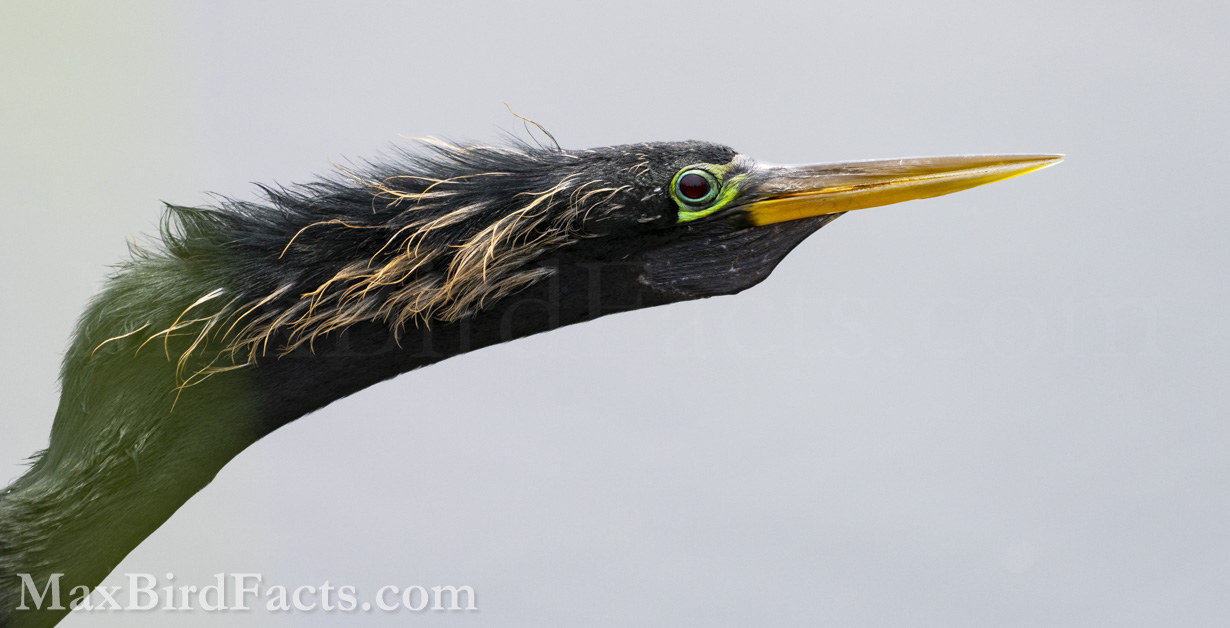
Only one genus, Anhinga, and four species are under the family Anhingidae. The one I’m focusing on in this article is the Anhinga (Anhinga anhinga) since it is the only species found in the New World.
The Anhinga was the first described species in this family, earning its scientific name in 1766 by the father of taxonomy himself, Carl Linnaeus. The other three species are the Oriental Darter (Anhinga melanogaster), African Darter (Anhinga rufa), and Australasian Darter (Anhinga novaehollandiae), each described in 1769, 1802, and 1847 respectively.
The word Anhinga stems from the Brazilian Tupi word a’ñinga, meaning “Snakebird.” Anhingas are still called Snakebirds today because of their long, slender neck that sticks out of the water as it swims.
The Anhinga is a striking bird and difficult to misidentify against other freshwater-loving species, like herons, egrets, and storks. They are medium-sized, averaging a little over 2.5 feet long, with a wingspan of around 3.5 feet.
The defining features across all four species are the bird’s long neck, dagger-like beak, overall dark or black plumage with white markings on their wing coverts, and exceptionally long tails.
We will go in-depth on these features when comparing them to their close cousins, the Cormorants. However, I want to quickly discuss one of their most underrated attributes, the Anhinga’s tail.
The Anhinga’s tail is remarkably long, roughly 30% of its overall length. This lengthy tail perfectly aids the bird both in flight and underwater. The bird can fan out its feathers in the air for additional maneuverability or shut it for a more suitable aerodynamic shape.
The story is much the same underwater; while chasing fish, the Anhinga can quickly open its tail to create drag for tight turns and then fold it away to speed after its slippery meal.
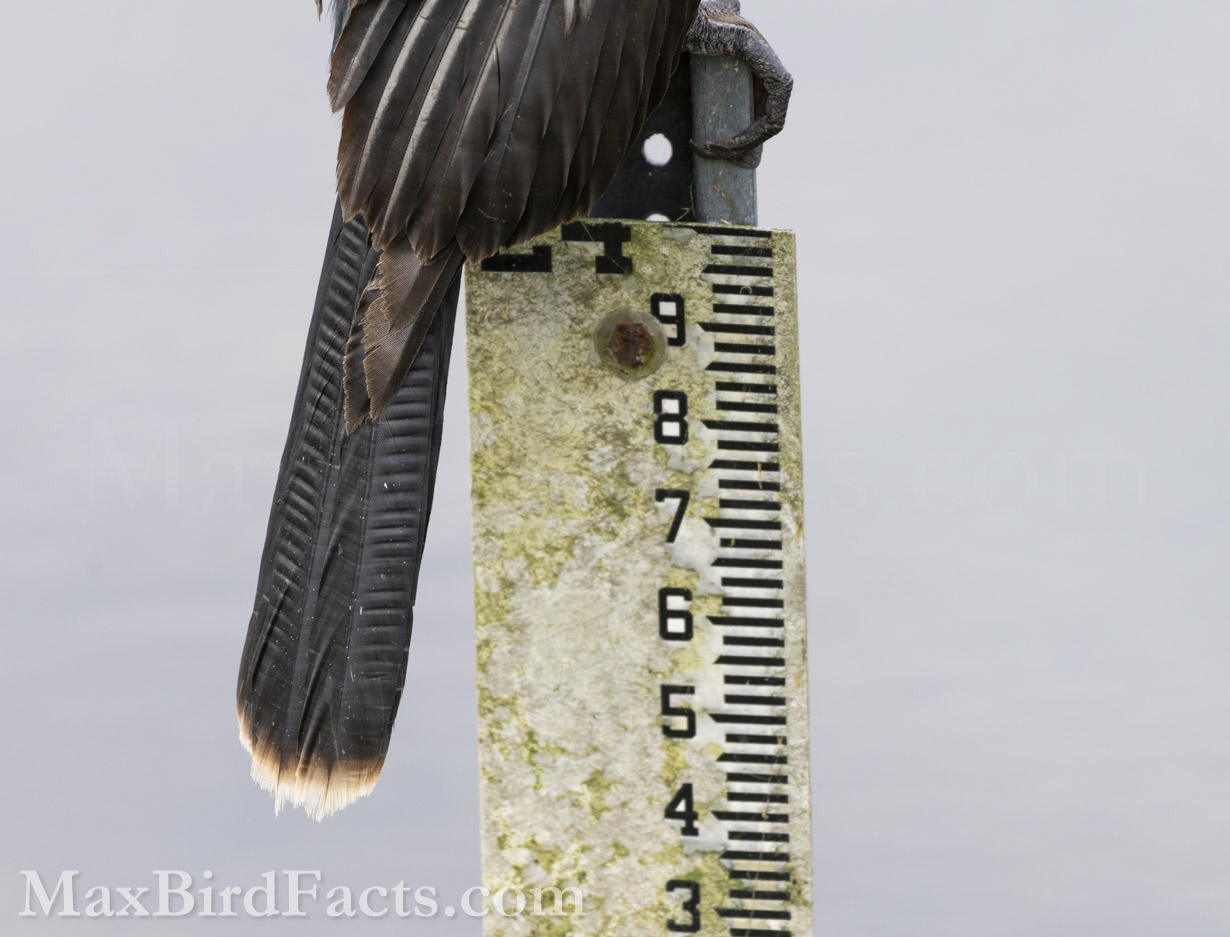
The tail’s form also earned the Anhinga another nickname, the “Water Turkey.” Because of its fan-like shape, people drew connections to a male Wild Turkey’s tail during a display.
Regardless, these peculiar birds are found in the freshwaters throughout Florida, Cuba, and South America (excluding the Andes), along the Gulf Coast of North America, and coastal Mexico and Central America.
Anhingas will occasionally meddle in brackish waters near mangroves and intercoastal zones, so be aware of this. However, they rarely hunt in salt water, so a salinity of around 17 ppm is their upper limit (ocean water averages 35 ppm, and freshwater is less than 0.5 ppm).
Like Cormorants and all of their relatives in the order Suliformes, Anhingas have webbed feet in the totipalmate toe arrangement. In the totipalmate format, the first digit is rotated forward and towards the body, and a thin membrane of flesh connects all four toes.
Rather than trying to swim using their wings, the Anhinga’s foot makes the perfect paddle underwater and propels it with incredible efficiency. Having all four toes webbed makes Anhingas speedy swimmers, but this comes at the cost of being a relatively clumsy walker.
The Anhinga’s plumage is sexually dimorphic, where the male and female are noticeably distinct. Young birds are pure white with naked, pink faces and soft, downy coats to keep them warm while their parents hunt for prey.
Male Anhingas are pure black, while the female has a black body and a soft brown head and neck. Adults of both sexes have intricate silvery-white feathers on their wing coverts and white tail tips.
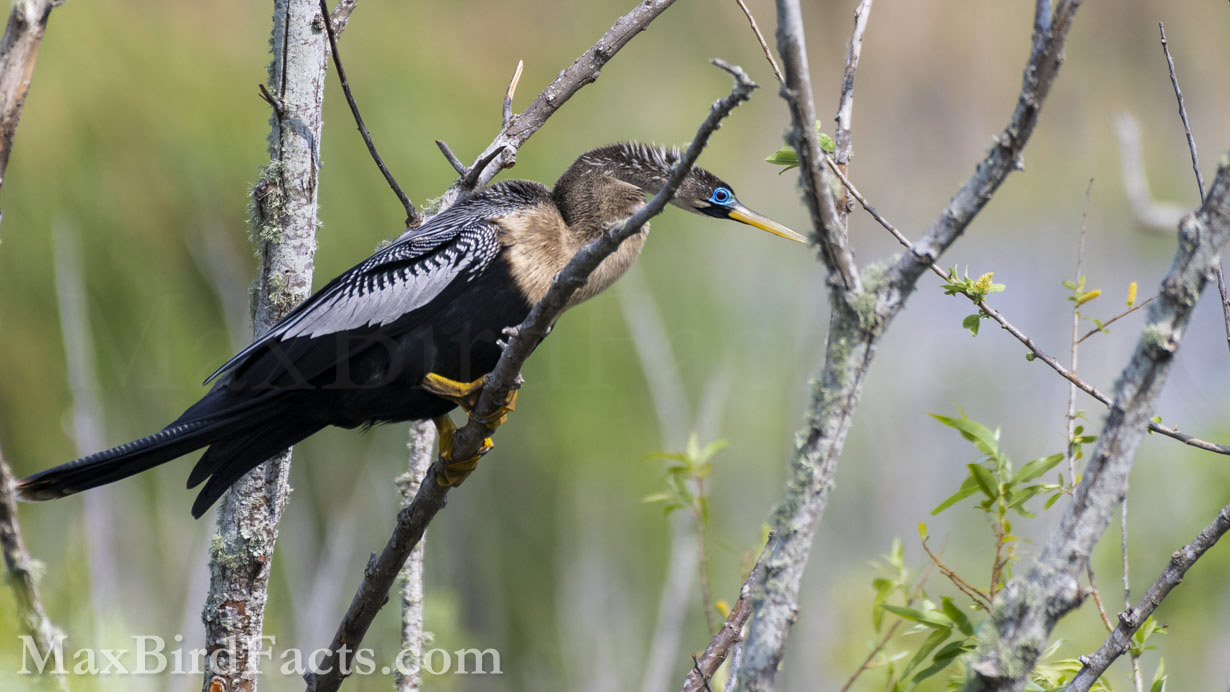
During the breeding season, both male and female birds will grow long, white manes, and the exposed skin on their faces changes color. But we will discuss that coloration later.
The dark color of this bird’s plumage makes it hard for fish to detect them. Stalking its prey, the Anhinga spears fish with its dagger-like beak before tossing its quarry into the air and swallowing it whole.
Though their diet is 98% fish, these pescetarians occasionally consume crawfish, insects, and plants. Anhingas even eat hackberries due to their high caloric density.
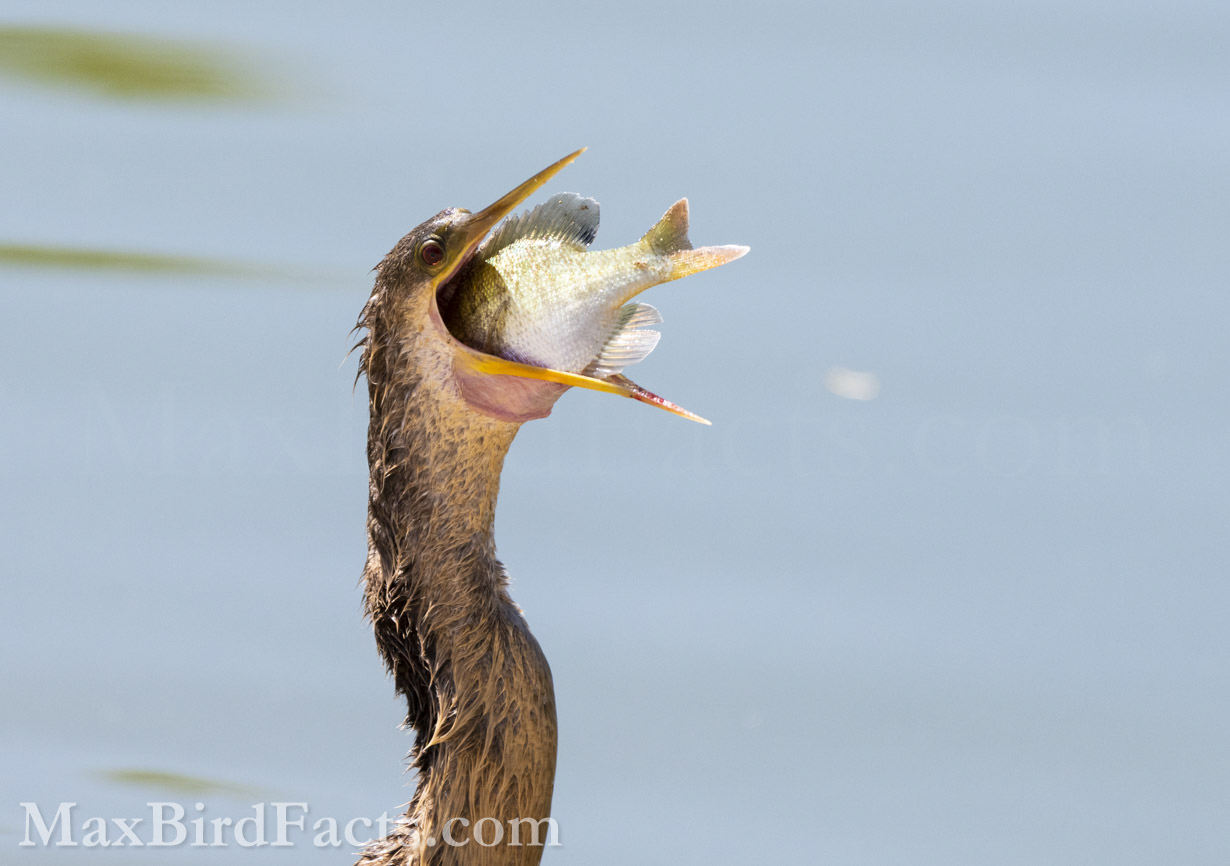
After swimming, Anhingas need to dry off for more efficient flight since their feathers aren’t waterproofed. This might seem like an odd choice for an aquatic bird, but it serves a vital purpose.
If you want to learn more about Anhingas and the reason why they don’t have waterproof feathers, you should check out my article How Does An Anhinga Thermoregulate – Warming Up After Swimming! Click or tap on the banner below to direct you right to it.
Cormorant — Family Phalacrocoracidae
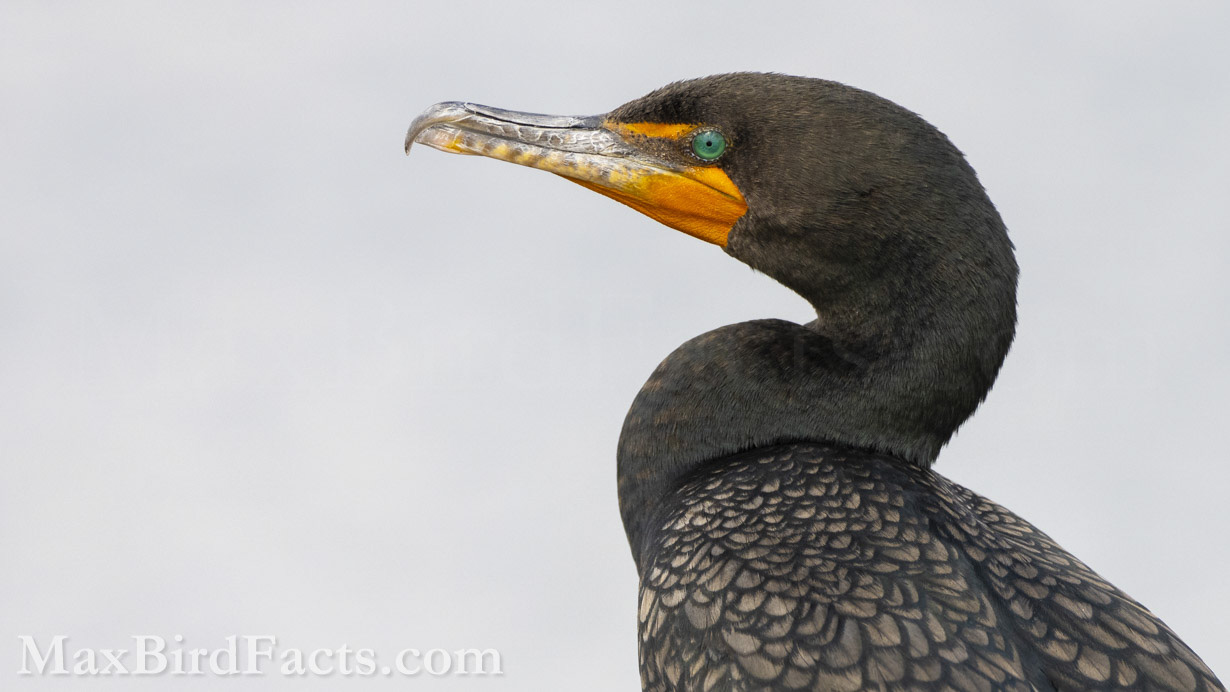
Unlike the Anhinga, the Cormorant family (Phalacrocoracidae) contains seven genera and 39 extant (living) species.
The name Cormorant itself finds its roots in the Latin corvus marinus, “sea raven,” due to their seemingly similar appearance to corvids. Even European sailors and explorers thought Cormorants were related to crows and ravens because of their black plumage and curved beaks.
Some members of this family are called Shags, referring to their “shaggy” crests, and the choice of naming a bird a Cormorant or Shag primarily concerned whether the bird had or lacked this disheveled plume.
Cormorants and Shags come in a plethora of sizes and colors. From shocking red facial skin, radiant blue gulars (fleshy throat pouch), ornate crests, counter-shading (dark above and light below) plumage, and golden fleshy knobs in front of their eyes, there is a massive array for a Phalacrocoracidae to appear.
However, I won’t go into depth on each of these species or genera. Still, the bird we are primarily focused on for this comparison is the Double-crested Cormorant (Nannopterum auritum).
The Double-crested Cormorant is a much more widespread species than the Anhinga, ranging throughout the New World, from the Greater Antilles Islands of the Caribbean in the Southeast to Newfoundland and Labrador, Canada in the Northeast, Puerto Vallarta, Mexico in the Southwest, and the Fox Islands of Alaska in the Northwest.
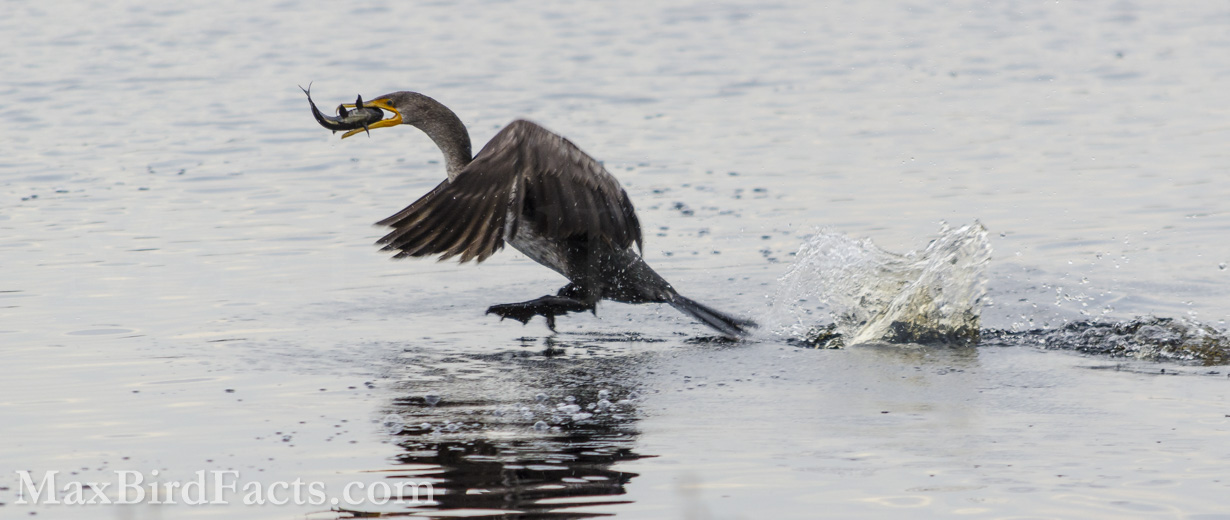
The Double-crested’s species name, auritum, is Latin for “long-eared.” This describer comes from the bird’s dual crests that it grows during the breeding season.
These crests are difficult to see on birds south of Alaska, having primarily black ridges to match their black plumage. Still, this plumage is an excellent indicator when identifying against its cousins in regions where they share habitats.
The Double-crested Cormorant is a stockier bird than the Anhinga with a shorter and slightly broader neck, curved beak tip, plump body, overall black or dark brown plumage, and apparent orange facial skin.
This bird is similar in size to the Anhinga, averaging slightly larger and heavier at 2.6 feet long and a wingspan of 3.9 feet. Like the Anhinga, the Cormorant is an aquatic bird that feeds primarily on fish.
However, digging deeper into the lifestyle of the Cormorant is where we begin to see the separations between these species.
Double-crested Cormorants are just as at home in saltwater as in freshwater. Because of this, the Cormorant is a much more opportunistic hunter, and they will happily snatch up crustaceans when they can.
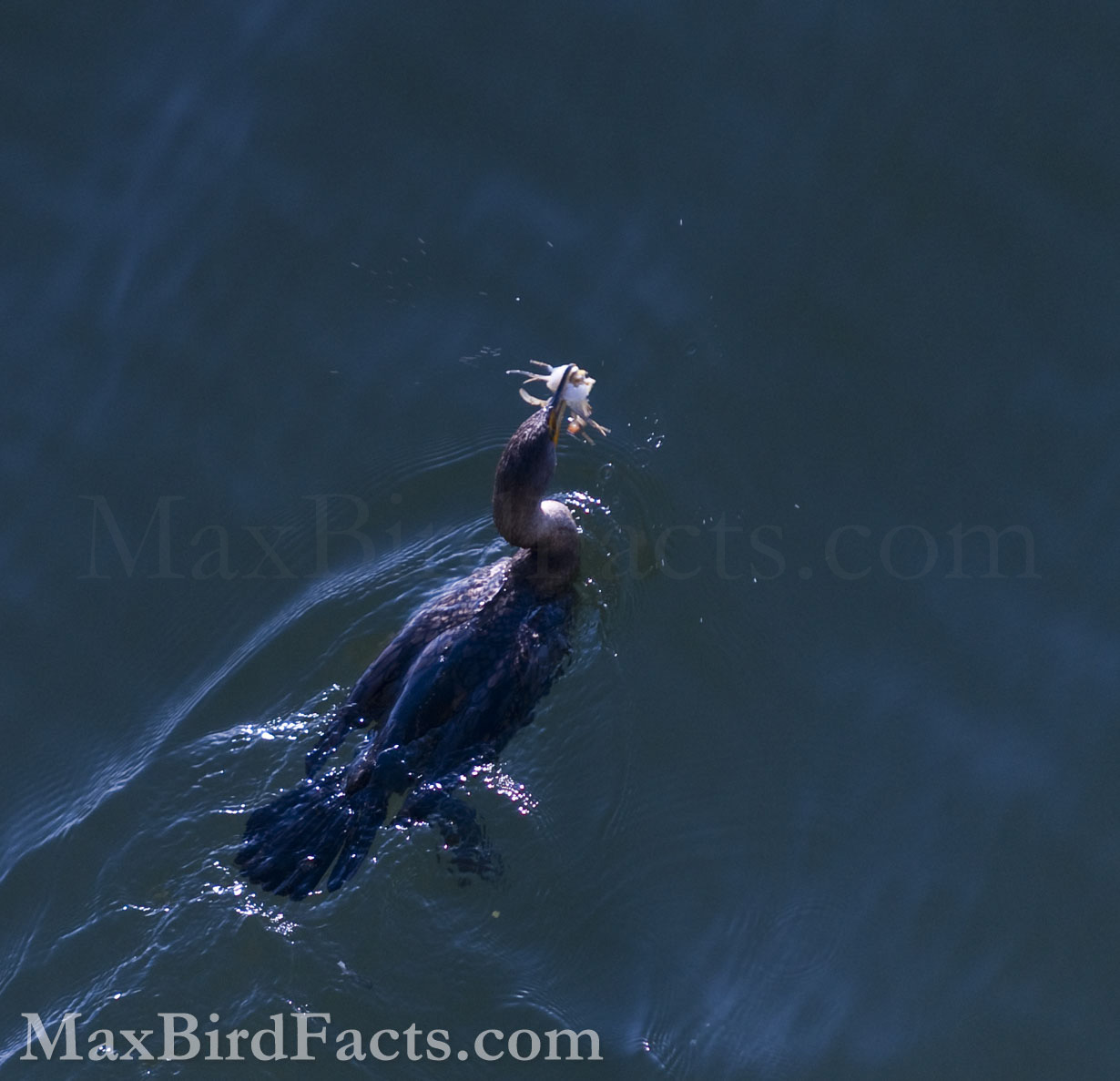
As stated earlier, both birds share the totipalmate foot arrangement, and the Cormorant uses this to its fullest extent. Stomach contents of Double-crested Cormorants show that over 50% of their diet comprises fish found around 300 feet below the waves.
Like the Anhinga, the Cormorant’s feathers lack waterproofing. From my observations, I believe there is slightly more waterproofing on the Double-crested than on the Anhinga, but marginally.
Both birds require a perch to dry their feathers before flying off after swimming. Yes, Anhingas and Cormorants can fly with wet feathers, but this will cost significantly more energy.
To put this into perspective, imagine the difference in energy expenditure if you tried to run a 5k with a backpack that weighed 20% of your body mass (i.e. 36 pounds if you weigh 180 lbs). You probably could still make it to the finish line, but how much longer would you take, and how much more effort would you have to exert carrying that extra mass?
Double-crested Cormorants lack the sexual dimorphism shown by Anhingas. All adult Double-cresteds are glossy black across their entire body, and they grow their iconic crests only during their breeding season.
Immature birds are dull brown with an ashy-gray belly and breast. Black natal down adorns hatchling Cormorants, compared to the white down on Anhinga hatchlings. In fact, nestling Double-crested Cormorants appear to be miniaturized versions of their parents.
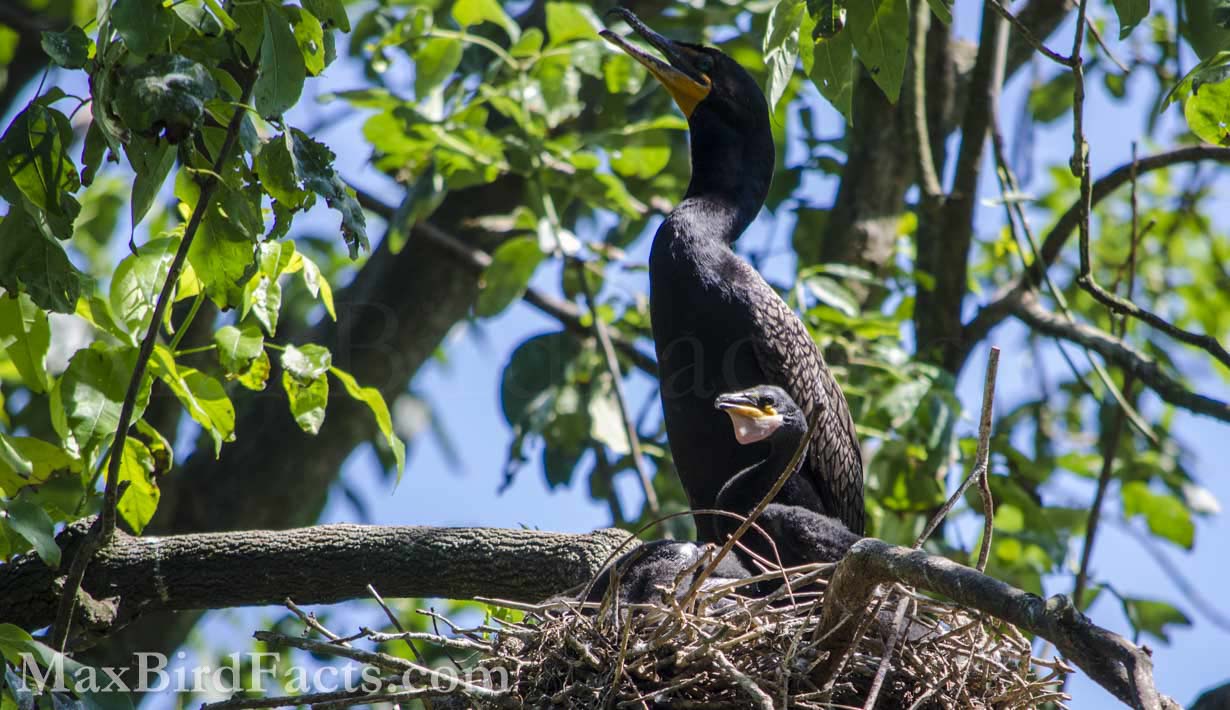
Finally, the method by which the Cormorant captures its prey is completely different from the Anhinga, which has to do with its beak.
The hook-shaped tip of the Double-crested Cormorant’s maxillary (upper) jaw allows it to seize and retain a wide variety of prey.
Because the Cormorant doesn’t spear its slippery prey and doesn’t need to pry it off its bill, so it can remain submerged while it swallows smaller fish.
Still, if the bird catches a larger fish that might slip away if it tried to consume it underwater, the Cormorant will surface, bash the fish against the water to stun it, flip it in the air, and swallow it headfirst.

Its hooked bill also makes it much easier to hold onto the hard shell of a crustacean and easily pry at the chinks in its armor to earn its meal. Overall, this hooked-tip seems to carry a much wider array of uses than the strait-pointed beak of the Anhinga.
So, now that we know the characters we are comparing, let’s start with the first and best identifiable difference between Anhingas vs. Cormorants.
Beak Shape — A vs. C
The bird’s beak is the first and simplest thing you should look for when identifying an Anhinga vs. Cormorant.
If the beak is straight as an arrow, it’s an Anhinga; if the beak is curved, it is a Cormorant.
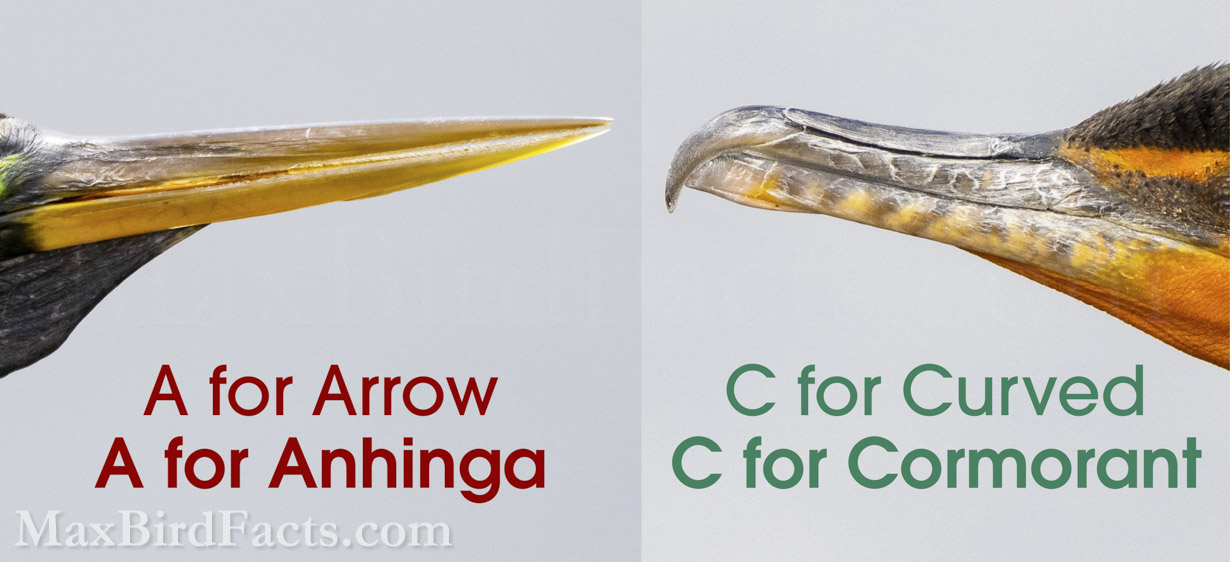
Easily observed at a distance, the bird’s beak should be your primary method of identifying an Anhinga vs. Cormorant. The sharp, fine-pointed beak of the Anhinga is unmistakable when side by side with a Cormorant’s hooked beak.
We’ve already discussed these birds’ beaks and how they fit their hunting styles accordingly.
Neither beak style is more or less viable than the other; it simply points to how that species has found a way to be successful.
The versatility of the curved beak on the Cormorant speaks to its need for a more versatile tool for the myriad of environments they haunt. The brutal efficiency shown in the Anhinga’s beak to effortlessly lance fish proves its prowess as an aquatic predator.
If we look closely at the Anhinga’s bill, we can see small rearward-facing serrations. This helps the bird retain the slippery fish it is trying to position before swallowing. Without these serrations, the fish could easily escape the otherwise smooth keratin.
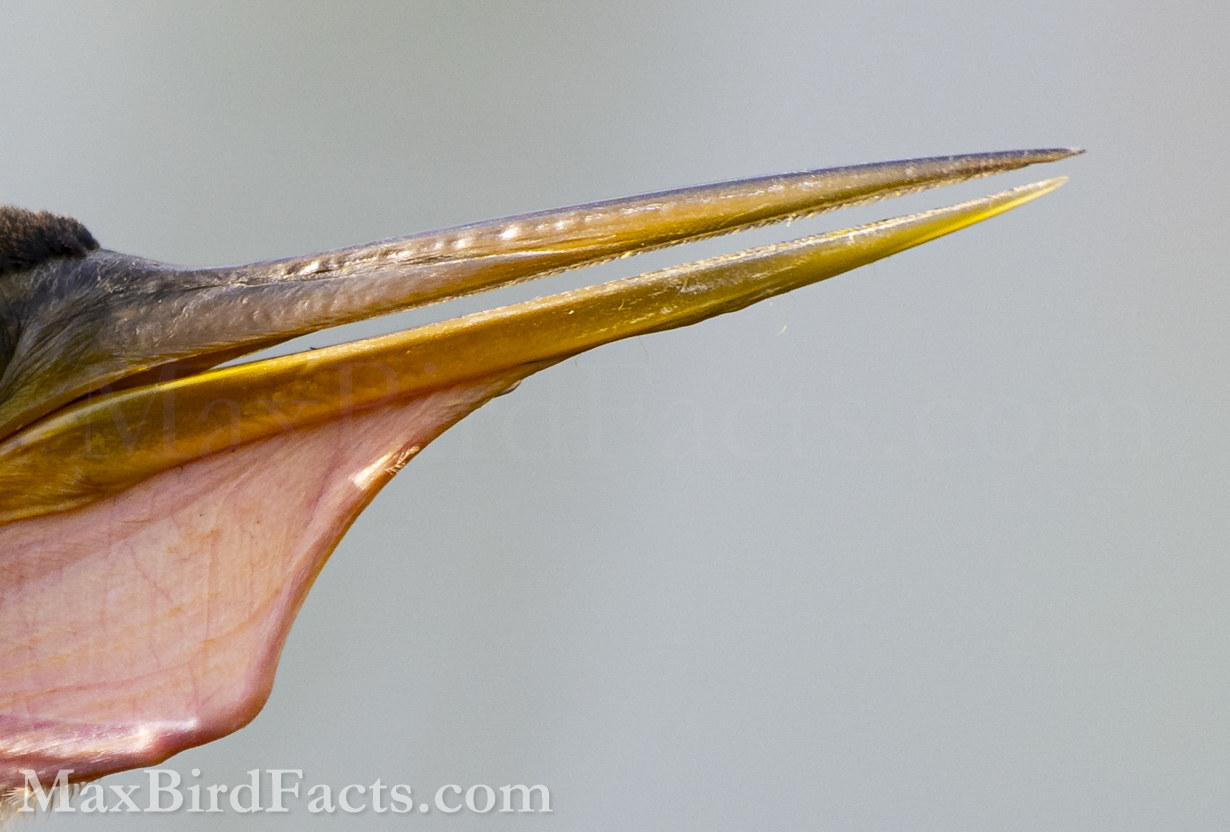
Looking at the Cormorant’s bill, these serrations seem to be lacking. This absence is likely due to the already curved nature of this bird’s beak, negating the need for additional traction.
Another interesting thing of note is the lack of nares, or the opening of the nasal passage, on both of these beaks. This is another adaptation for Suliformes that aids in their aquatic ability.
Many Suliformes that hunt below the waves have lost their nares for the benefit of a much lower risk of inhaling water or allowing water to enter their nasal passage when plunging into the water.
Now, let’s look at the second feature that should readily point you to the correct conclusion. And, thankfully, it isn’t too far from the bird’s beak.
Eye Color and Facial Skin — Red vs. Blue
If you have the time to inspect the bird’s beak, you likely can also see its eyes, which are the second key feature to scrutinize on an Anhinga vs. Cormorant.
Anhingas have maroon-red eyes, while Cormorants have turquoise-blue eyes.
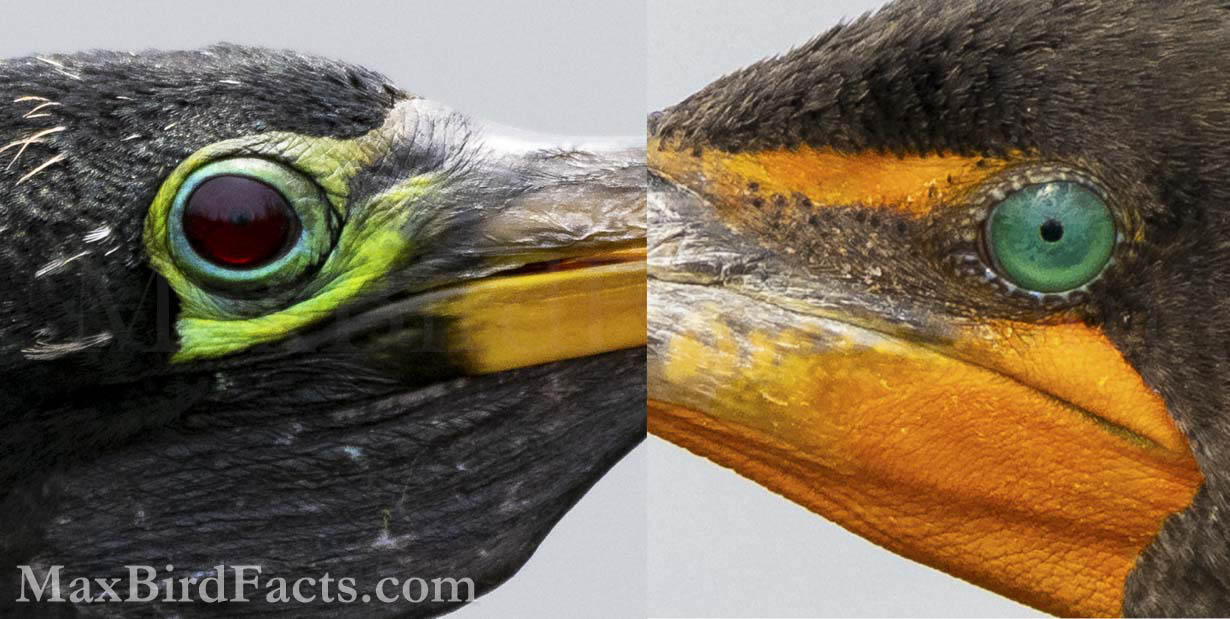
This color difference is readily apparent in adult birds regardless of sex. The facial skin is another feature of note, especially during the breeding season.
During the breeding season, Anhingas have vibrant blue bare skin surrounding their eyes and the base of their bill, and their gular turns black, while Cormorants have orange skin in front of their eyes and covering their throat and mouth.
During the non-breeding season, the Anhinga’s facial skin returns to its typical greenish-yellow, and gular fazes back to a fleshy pink color. However, the Cormorant’s facial skin remains the same bright orange year-round. Nonetheless, the inside of its mouth changes to a stunning electric blue.
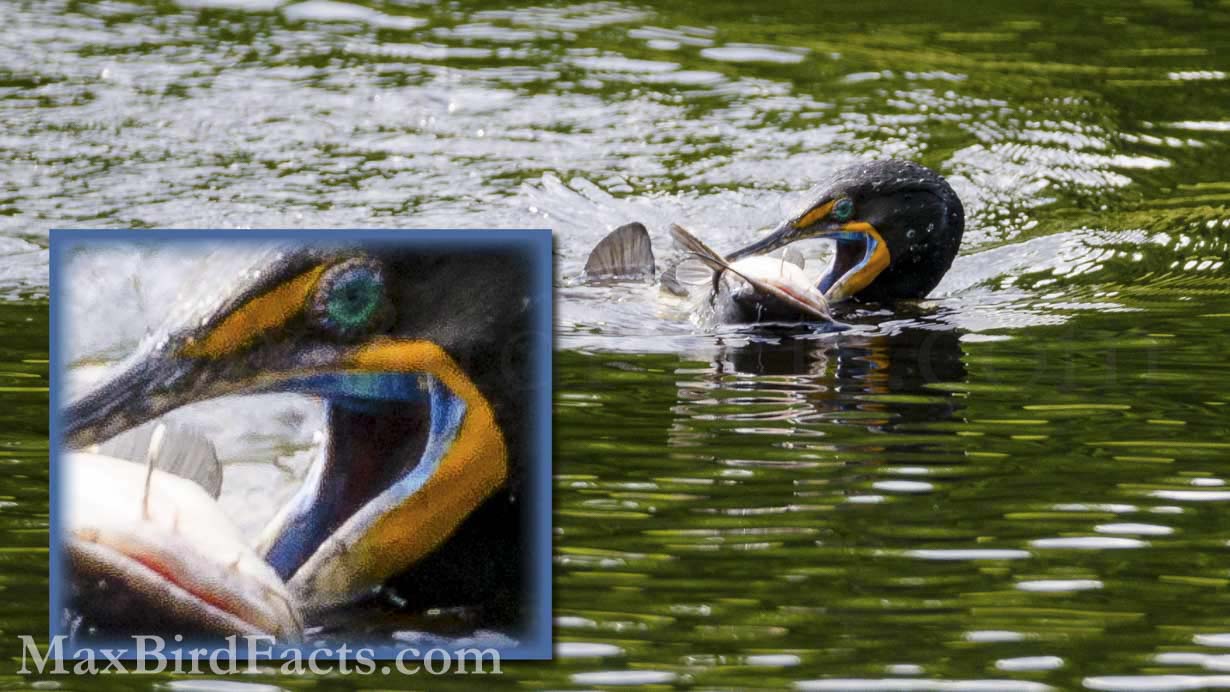
Unfortunately, little is known about why different avian species have such extraordinary iris coloration, and plenty of researchers are searching for this answer today. Yet, I can still speculate.
Similar to the status of a bird’s plumage, its eye color could disclose vital information to other birds around it.
Specifically looking at the Double-crested Cormorant, juvenile birds have dull blackish-brown irises compared to the fiery azure of the adult.
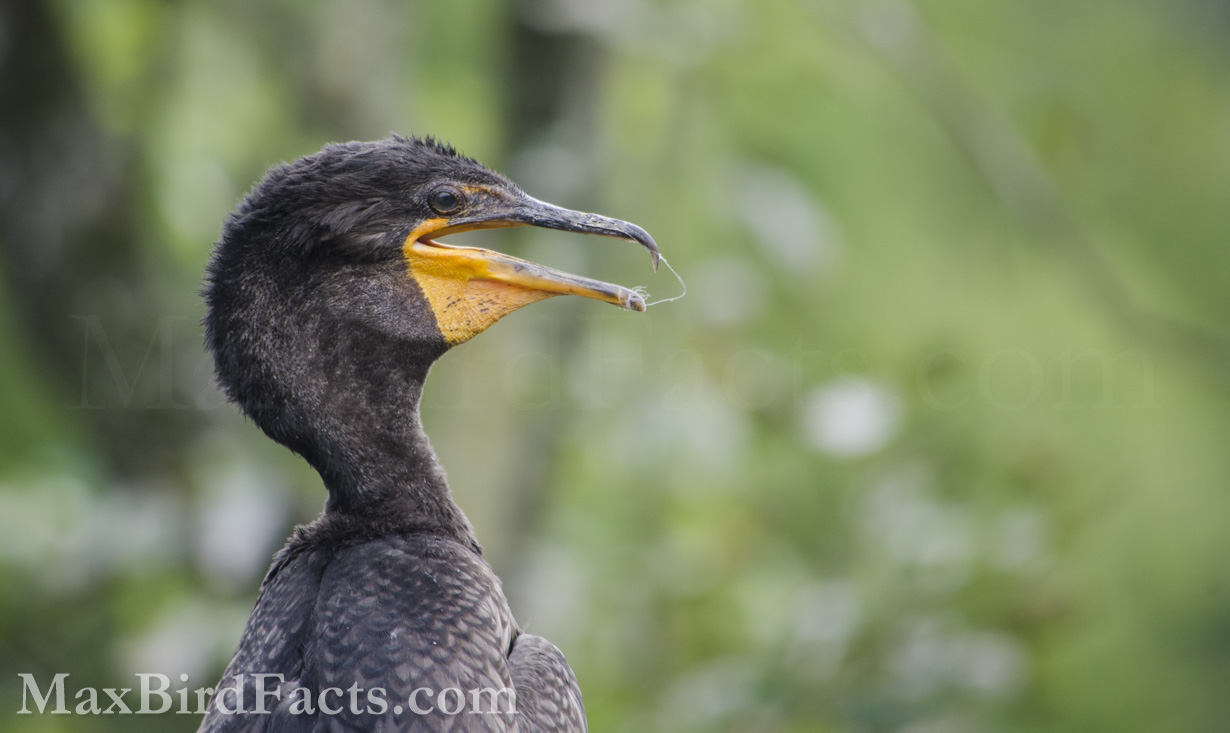
This could indicate to adult birds that this younger individual isn’t a threat against its nesting site or a possible rival it would need to fight, saving both the adult the energy of chasing off the youngster and the juvenile Cormorant the potential injury from an attack.
This theory seems to apply to the Anhinga, where juvenile birds have a dull gray iris rather than the adult’s garnet eyes.
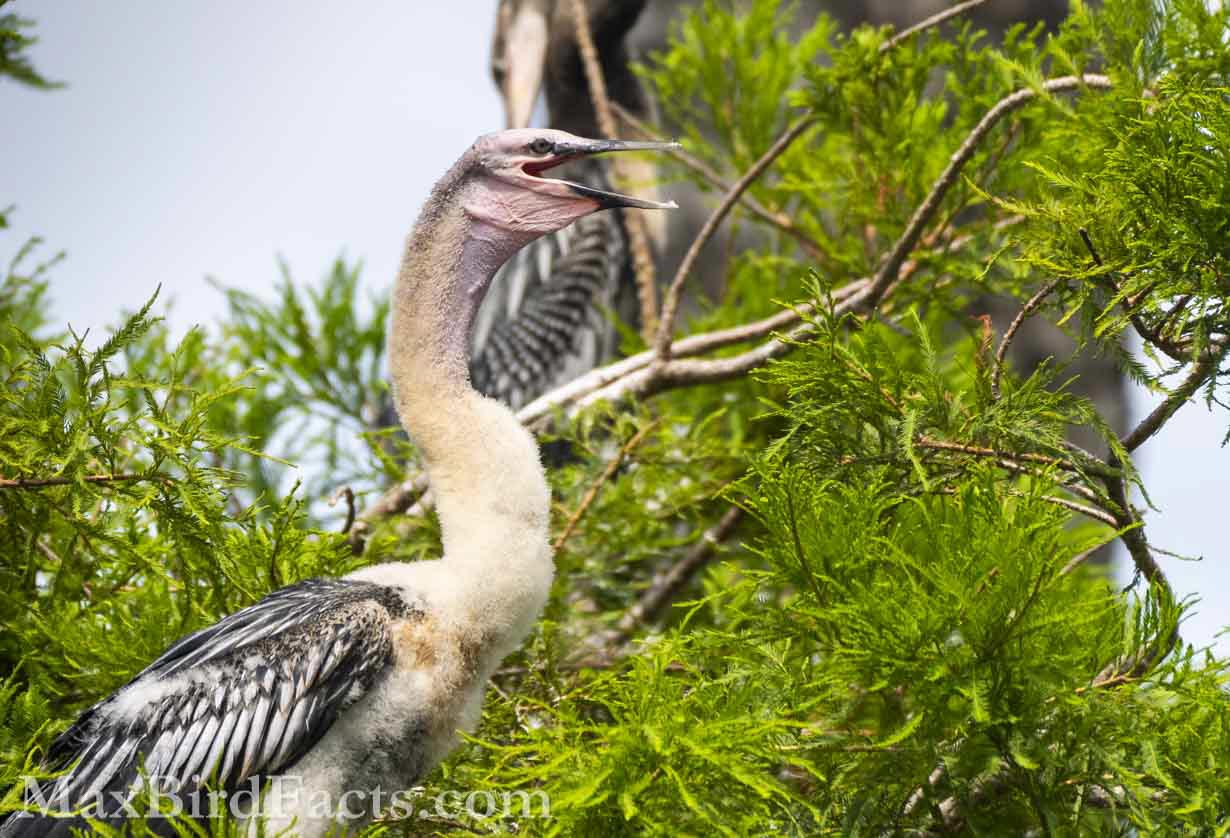
Again, this muted eye coloration could act as a reliable, honest signal to prevent it from being seen as a threat to other nesting Anhingas. Yet, I don’t see this mistaken identity as much in Anhingas as in Cormorants since the young Anhinga is a completely different color compared to its adult counterpart.
Regardless, remember, Anhingas have red eyes and blue facial skin, while Cormorants have blue eyes and orange facial skin.
Finally, let’s inspect the final nail in the coffin for identifying an Anhinga vs. Cormorant.
Tail Length — Size Matters
As stated earlier, the Anhinga’s tail is nearly 30% of its body length. However, the Cormorant’s tail is only 15-20% of its entire length.
The Anhinga’s tail dwarfs the Cormorant’s.
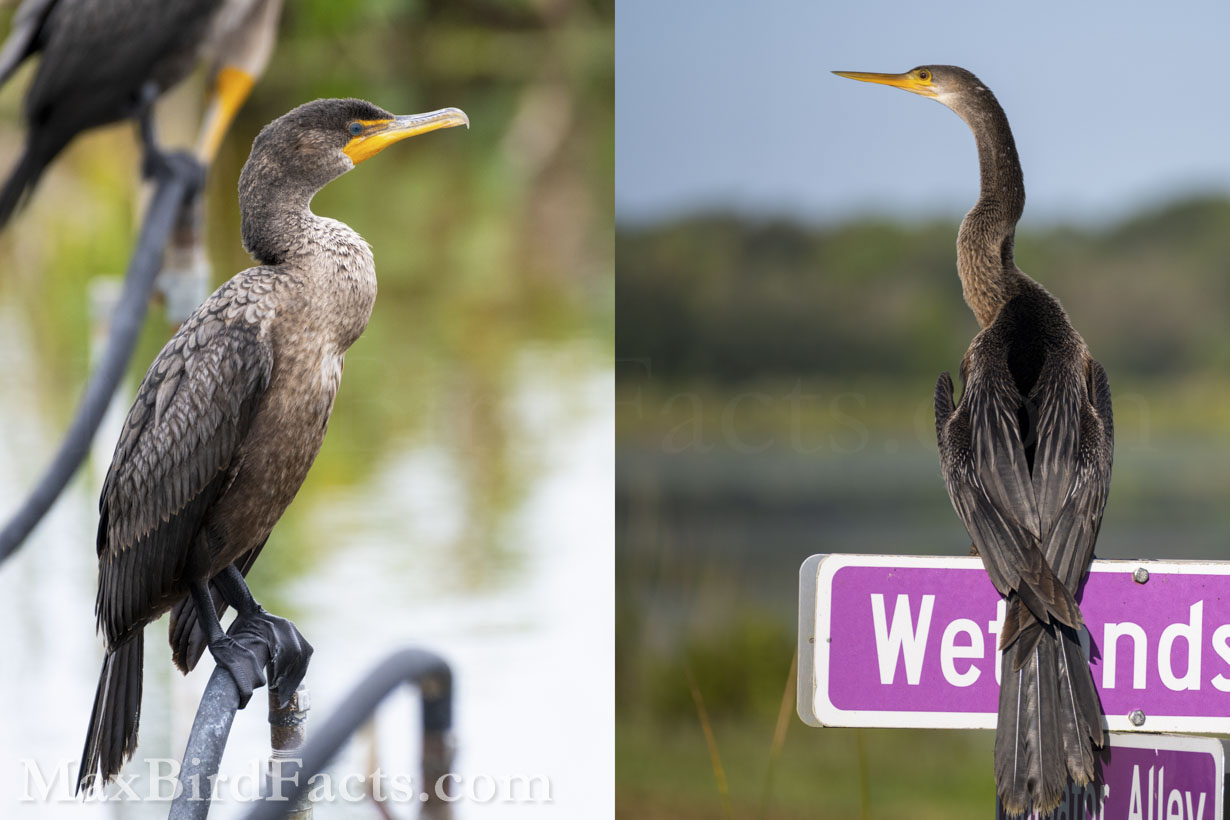
This fact is apparent when the birds are perched. The Anhinga’s tail looks roughly the same length as its neck, while the Cormorant’s goes slightly past its feet.
The Anhinga has a much more paddle-shaped tail. As we discussed earlier, this allows the bird to make tight maneuvers both in the air and underwater.
The Cormorant’s tail appears more boxy when folded and shorter than the Anhinga’s when fanned out. As stated previously, its diminished length could be advantageous in the rougher waters of the ocean.
The length and shape of the rectrices (tail feathers used for flight) is also an easy feature to see in flight.
In the air, the Anhinga’s tail appears as long or longer than its head and neck, whereas the Cormorant’s head and neck are clearly longer than its tail.

The white tips of the Anhinga’s tail should also tell which species you’re looking at. Compare this to the uniform black coloration of the Cormorant from throat to tail termination.
Again, the Anhina’s tail comes to a very rounded tip when fully closed and is a broad paddle-shape when fanned out. The Cormorant’s tail, however, appears to go to a dull point when folded in flight and a smaller, rounder fan shape when extended.
Now We Know How To Identify Between Anhinga vs Cormorant!
Now, you should have no issues identifying between an Anhinga vs. Cormorant!
Remember the three keys to identifying between Anhinga vs. Cormorant:
- Beak Shape: A for Arrow, A for Anhinga; C for Curved, C for Cormorant.
- Eye Color and Facial Skin: Red eyes and blue skin for Anhingas; turquoise eyes and orange skin for Cormorants.
- Tail Length: Long tail for Anhingas; short tail for Cormorants.
Also, keep in mind the length of the bird’s neck; the Snakebird earned this name for a reason.
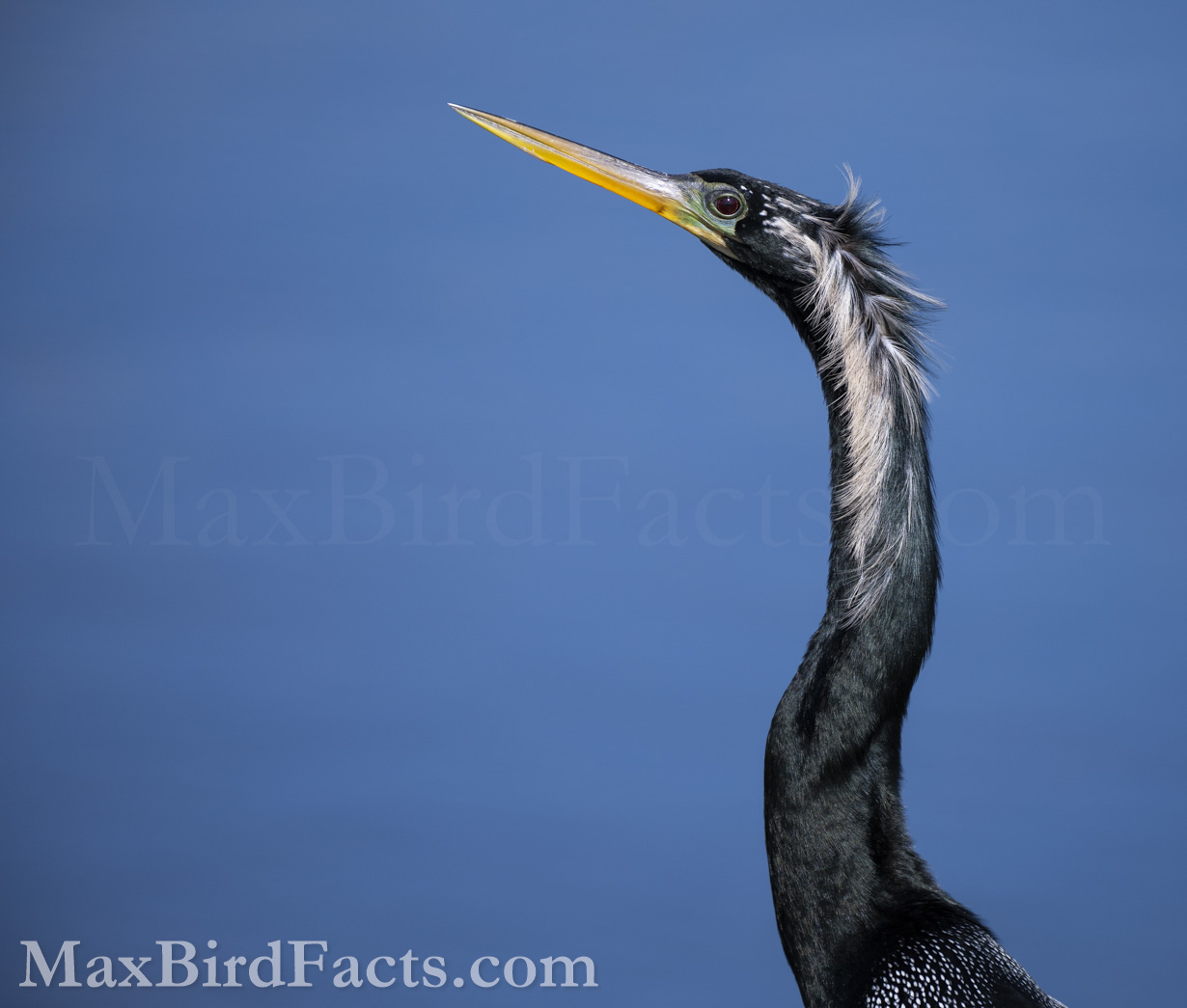
Anhingas almost exclusively remain in and near freshwater but occasionally hunt in brackish mangroves, whereas Cormorants are content with any salinity level. So, if you are on the coast and see a mid-sized, dark-colored bird perched on driftwood with its wings spread, you are likely observing a Cormorant.
Still, It isn’t impossible that an Anhinga lost its way and found a nice beachfront property to enjoy for a few days. So take the time to check this mystery bird’s beak, eyes, and tail to be 100% certain before making your definitive answer.
I really hope you enjoyed learning about the differences between Anhingas and Cormorants and why those differences make them such fascinating species to study.
If you have ideas or suggestions for topics you would like me to write about in the future, feel free to leave a comment below or shoot me an email!
If you enjoyed this article, please subscribe to my email list to be the first to know when I post new articles!
Get Outside & Happy Birding
Max

Another great article. Thanks Max
Thank you Dan!!!
Pingback: Beginner Birding and Learning Identification Techniques – Marion Audubon Society Walk at Tuskawilla Park, Ocala, Florida – Welcome to MaxBirdFacts.com!!!